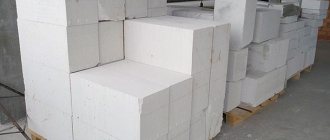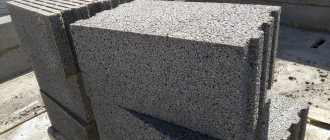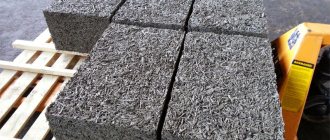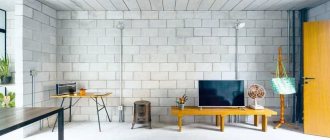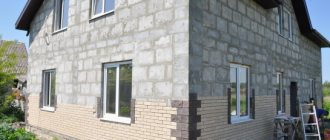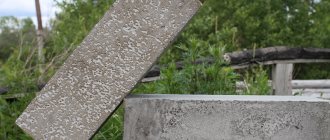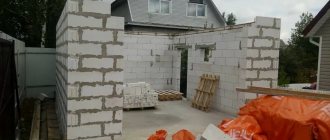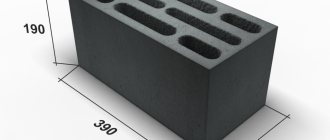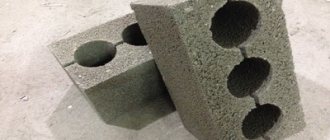Gas silicate products are used in the construction industry. The block production process is carried out under high pressure, as well as under natural conditions. Thanks to their porous structure, they retain heat well. The D500 gas silicate block is popular, the characteristics of which make it possible to use this material in the construction of houses. As a result of the use of blocks of increased sizes, the building construction cycle is shortened. Let's look at the main technical characteristics that need to be taken into account when choosing a material.
BUY A GAS BLOCK FROM THE MANUFACTURER IN MOSCOW
Cellular concrete for building houses is an innovative material that is very actively used in construction. It is universal, so it is suitable for the construction of completely different walls. Below is a detailed description of the operational and technical characteristics of the material, which is currently preferred by many builders. Our company makes sure that you can buy aerated blocks without problems, markups and overpayments. A large number of manufacturers produce aerated concrete on the market, but not every manufacturer is so careful about the quality of their products and it often happens that they are of dubious quality and do not meet the developer’s expectations. Therefore, you should approach the study of factories very carefully; we are always ready to help with the choice and advise on all questions that interest you. Gas silicate is considered an artificial stone, which is produced from one of the many types of concrete. Its production is extremely simple, the price is much lower than similar products, but the quality of such a product is average. It is worth noting that such material appeared on the construction market not long ago and is only gaining popularity.
A better alternative to concrete blocks is ceramic brick. You can find a comparison of building blocks and ceramic bricks in the article below, or by contacting our specialists for a free professional consultation.
RESULT
Some experts are skeptical about the use of gas silicate blocks in the construction of load-bearing walls, arguing that when constructing a multi-story building, a reliable frame is necessary. There is a standard STO 501-52-01-2007 “Design and construction of enclosing structures of residential and public buildings using cellular concrete in the Russian Federation”, which clearly indicates recommendations and technical conditions for using gas silicate in construction. It is important to comply with technological requirements and then gas silicate blocks will help solve the problems.
The article was written for the site.
Tags: Foam block and Gas block
Comparative characteristics
The fact is that comparing aerated concrete blocks (or as aerated concrete, cellular blocks are also called) is not entirely correct and their use is different. Gas silicate is used only as a filler, without load-bearing properties of the wall, under conditions of low humidity. According to SNIP rules, aerated concrete, oddly enough, must be insulated and must be closed from the external environment (for example, with facing bricks). When erecting walls, an armored belt for the building structure is required, since the strength grade is only M25, which is not required when using ceramic blocks (grade M150-M200). Foam concrete is afraid of high temperatures; at temperatures above 400 degrees, it completely loses its strength and turns into sand (for example, after a small fire in the house). We do not recommend using partition blocks since hanging plasma and heavy cabinets on this wall will be problematic (the anchors will fly out).
| Gas block | Ceramic brick | |
| Cost per cube | 4200 rub. | 3000 rub. |
| Strength | M-35 | M-150 |
| Frost resistance | F25 | F100 |
Gas block and gas silicate
A gas block is an artificial stone having cells with a diameter of 1 to 3 mm. They are evenly distributed throughout the entire structure of the material. It is the degree of uniformity of these bubbles that affects the quality of the final material. When producing aerated concrete blocks, the basis is cement with autoclave or natural hardening.
Gas silicate is a material based on lime. In addition to it, the composition includes: sand, water and gas-forming additives. The blocks are autoclaved. The mixture for gas silicate is poured into a mold and undergoes furnace heat treatment, after which the finished block is cut with a string into smaller blocks of the required size.
Aerated blocks have a lower noise insulation coefficient. If gas silicate absorbs moisture and its structure suffers as a result, then the gas block passes it through itself, creating a comfortable microclimate in the room.
Due to their uniform porosity, gas silicate blocks are more durable. And they are more expensive than less durable gas blocks.
table 2
Inexpensive aerated concrete blocks
You can find inexpensive aerated concrete blocks from the manufacturer by calling the sales house of the production plant. After finding out how much the material costs, you can call the official website. The best factories in the Moscow region:
- Drauber Elektrostal official website;
- Bonolit official site Staraya Kupavna;
- Aerostone Dmitrov official website;
- Yutong official website;
- Poritep;
- Kaluga official website Siberian element;
- ECO plant;
- Thermocube Kostroma;
- Egoryevsky plant official website;
- OJSC Kostroma Silicate Plant;
- Lipetsk silicate plant official website price.
This building material is much more expensive than double ceramic bricks. Reviews vary on wall blocks or, as blocks made of cellular concrete are called, wall and partition blocks. A turnkey house price is 20% higher than a house made of M-150 brick (double brick 2.1nf).
Disadvantages of aerated concrete
Despite a number of advantages, wall material has significant disadvantages. When choosing it as a building material, one must take into account the type of soil, the proximity of groundwater and the climate of the region.
- Requires additional waterproofing, since porosity increases the sorption of water from air and soil by an order of magnitude.
- Special glue is used for installation. The cold enters the room through the seam of the masonry. The blocks are laid in dense rows; glue based on Portland cement allows you to make a seam 3 mm thick.
- Skewing of the horizontal surface by more than 3 mm per 2 m of length is not allowed. The laying starts from the corner and every 2 meters the slope is checked with the level.
Dimensions and specifications
Standard size is 600x200x300.
However, there are others; it is important to understand the basic dimensions. The length of the foam block can be 600 mm or 625 mm. The height can be 200 mm or 250 mm. For the construction of external load-bearing walls, thicker products should be used, and for the construction of partitions, material with a smaller thickness will do. The characteristic is density: D300 - the warmest, D400, D500, D600, the strongest block - D700
Video description
About whether it is possible to do without insulating walls made of aerated concrete - in the following video:
- Under aerated concrete and gas silicate blocks, waterproofing material must be laid on the foundation;
- To prevent shrinkage and destruction of the walls, during the laying of the blocks, reinforcement is made in the first and every fourth row, as well as in the area of window openings.
Reinforcement of a load-bearing wall during the construction of a house made of aerated concrete Source zaggo.ru
Feature 600mm length
| Main manufacturers: Aerostone, Bonolit, Drauber, El Blok, Eco, Kaluga plant | Number of cubes in the car | ||||||
| Size LxHxW | Volume in m3 | Quantity per 1 m3 | Quantity per pallet (pcs) | Pallet volume (m3) | D400 D400 | D500 D500 | D600 D600 |
| 600x200x50 | 0,006 | 167 | 300 | 1,8 | 36 | 32,4 | 28,8 |
| 600x200x75 | 0,009 | 111 | 200 | 1,8 | 36 | 32,4 | 28,8 |
| 600x200x100 | 0,012 | 83 | 150 | 1,8 | 36 | 32,4 | 28,8 |
| 600x200x125 | 0,015 | 67 | 120 | 1,8 | 36 | 32,4 | 28,8 |
| 600x200x150 | 0,018 | 56 | 100 | 1,8 | 36 | 32,4 | 28,8 |
| 600x200x200 | 0,024 | 42 | 80 | 1,92 | 36 | 32,4 | 28,8 |
| 600x200x250 | 0,03 | 33 | 60 | 1,92 | 36 | 32,4 | 28,8 |
| 600x200x300 | 0,036 | 28 | 50 | 1,8 | 36 | 32,4 | 28,8 |
| 600x200x375 | 0,045 | 22 | 40 | 1,8 | 36 | 32,4 | 28,8 |
| 600x200x400 | 0,048 | 21 | 40 | 1,92 | 36,5 | 32,6 | 30,7 |
| 600x200x500 | 0,06 | 17 | 30 | 1,8 | 36 | 32,4 | 28,8 |
| 600x250x50 | 0,0075 | 133 | 192 | 1,08 | 36 | 32,4 | 28,8 |
| 600x250x75 | 0,011 | 91 | 160 | 1,8 | 36 | 32,4 | 28,8 |
| 600x250x100 | 0,015 | 67 | 120 | 1,8 | 36 | 32,4 | 28,8 |
| 600x250x125 | 0,01875 | 53 | 80 | 1,35 | 36 | 32,4 | 28,8 |
| 600x250x150 | 0,022 | 45 | 80 | 1,8 | 36 | 32,4 | 28,8 |
| 600x250x200 | 0,03 | 33 | 64 | 1,92 | 36,5 | 32,6 | 30,7 |
| 600x250x250 | 0,0375 | 27 | 48 | 1,8 | 36 | 32,4 | 28,8 |
| 600x250x300 | 0,045 | 22 | 40 | 1,8 | 36 | 32,4 | 28,8 |
| 600x250x375 | 0,05625 | 18 | 32 | 1,8 | 36 | 32,4 | 28,8 |
| 600x250x400 | 0,06 | 17 | 32 | 1,92 | 36,5 | 32,6 | 30,7 |
| 600x250x500 | 0,075 | 13 | 24 | 1,8 | 36 | 32,4 | 28,8 |
How to correctly calculate the number of units
Most manufacturers produce products in different shapes and sizes. The cost of building material is determined per 1 m3. Products with dimensions of 20x30x60 cm are considered the most popular. There is a need to find out how many blocks are in a 300x200x600 foam block cube. The volume of one product is calculated using the formula: length multiplied by width and height. If you make calculations, you can easily determine the volume of one standard product. It is equal to 0.036 m3. If 1 m3 is divided by 0.036 m3, the result will be 27.78. Using this method, they calculate how many blocks are in a cube.
The number of units in one cube depends on the size of the block Source stroy-podskazka.ru
See also: Catalog of block house projects
Size chart of the best blocks 625 mm long
| Bonolit, Kaluga aerated concrete, Poritep, Aerostone | in the car (cubes) | ||||||
| Size LxHxW | Volume in m3 | Quantity m3 | Quantity per pallet (pcs) | Pallet volume (m3) | D400 D400 | D500 D500 | D600 D600 |
| 625x200x75 | 0,0093 | 108 | 200 | 1,875 | 35,62 | 31,87 | 28,12 |
| 625x200x100 | 0,0125 | 80 | 150 | 1,875 | 35,62 | 31,87 | 28,12 |
| 625x200x125 | 0,0156 | 64 | 120 | 1,875 | 35,62 | 31,87 | 28,12 |
| 625x200x150 | 0,0187 | 53 | 100 | 1,875 | 35,62 | 31,87 | 28,12 |
| 625x200x200 | 0,025 | 40 | 80 | 2 | 36 | 32 | 28 |
| 625x200x250 | 0,0312 | 32 | 60 | 1,875 | 35,62 | 31,87 | 28,12 |
| 625x200x300 | 0,0375 | 27 | 50 | 1,875 | 35,62 | 31,87 | 28,12 |
| 625x200x375 | 0,046875 | 21 | 40 | 1,875 | 35,62 | 31,87 | 28,12 |
| 625x200x400 | 0,05 | 20 | 40 | 2 | 36 | 32 | 28 |
| 625x200x500 | 0,0625 | 16 | 30 | 1,875 | 35,62 | 31,87 | 28,12 |
| 625x250x50 | 0,0078 | 128 | 240 | 1,875 | 35,62 | 31,87 | 28,12 |
| 625x250x75 | 0,0117 | 85 | 160 | 1,875 | 35,62 | 31,87 | 28,12 |
| 625x250x100 | 0,0156 | 64 | 120 | 1,875 | 35,62 | 31,87 | 28,12 |
| 625x250x125 | 0,0195 | 51 | 96 | 1,875 | 35,62 | 31,87 | 28,12 |
| 625x250x150 | 0,0234 | 43 | 80 | 1,875 | 35,62 | 31,87 | 28,12 |
| 625x250x250 | 0,039 | 26 | 48 | 1,875 | 35,62 | 31,87 | 28,12 |
| 625x250x300 | 0,0468 | 21 | 40 | 1,875 | 35,62 | 31,87 | 28,12 |
| 625x250x400 | 0,0625 | 16 | 32 | 2 | 36 | 32 | 28 |
| 625x250x500 | 0,0781 | 13 | 24 | 1,875 | 35,62 | 31,87 | 28,12 |
Cellular concrete for house construction
We advise you to buy the material inexpensively in Moscow at a favorable price in winter and you will receive a house project made of gas silicate for free in favor of cooperation with our company. On the trading platform you can buy double hollow slotted brick M150, one and a half bricks, glue for blocks, buy bricks in Moscow, single solid bricks, dry mix m 150, sand concrete m 300, insulation.
The SSK company regularly organizes profitable promotions, thanks to which you can purchase aerated concrete blocks and ceramic bricks which will be the most profitable on the market. In our catalog you will also find foam concrete blocks. Foam block sizes are indicated in tables, manufacturers and quality certificates.
Now foam blocks can be ordered at a discount, which will help save a significant part of the budget for building a house. If you would like advice on cost and size, please call the number listed on our website.
Wall blocks advantages
| Installation is quick and fireproof; |
| Smooth geometry, low glue consumption; |
| Lightweight and comfortable laying. |
Gas blocks cons
| The strength grade is from M25 to M35, so the construction of wall blocks requires an armored belt (depending on the density from D400 to D700); |
| High water absorption (in humid weather, masonry is PROHIBITED; if the block is wet, then it is almost impossible to get rid of the fungus and frost resistance decreases several times, thermal conductivity also tends to zero, “total freezing”); |
| Shrinkage is at least 2 mm every year, so finishing renovation of a house or apartment is not recommended for several years; |
| In Europe (in Germany), it is PROHIBITED to use houses made of aerated concrete blocks for permanent residence or to stay there for more than 8 hours a day, since the production uses harmful material that causes oncology - aluminum powder. Houses made of aerated concrete blocks are acceptable only as warehouses or hangars. Back in the 80s in Moscow, before the 1980 Olympics, there was a decree that prohibited the construction of houses from gas silicate blocks, even during a period of total shortage of ceramic bricks. |
Laying blocks price per cube
Unlike brick, gas silicate is easier to lay and does not require special qualifications and training of workers. This is due to its structure and technical characteristics: it can be easily machined and is an order of magnitude lighter than brick, and the blocks themselves are large in size, which also significantly speeds up the construction process. Despite this, you are unlikely to be able to lay out the wall yourself. In this case, our company has a service of workers who can professionally carry out masonry of any complexity at affordable and comfortable prices. You can view prices for masonry services HERE. If you are still at the stage of choosing a project for your home, then we have a special PAGE WITH FREE READY-TO-DATE HOUSE PROJECTS.
Gas silicate or aerated concrete - what is the difference?
The difference between gas silicate blocks and aerated concrete blocks lies in their composition. In the production of gas silicate, high-slaking lime is used as the main ingredient, which does not make the blocks super strong compared to other similar materials, but is characterized by high sound and heat insulation. When producing aerated concrete blocks, the main ingredient is cement. Because of this, aerated concrete blocks are more durable, but have reduced sound and heat insulation properties.
Also, blocks made of gas silicate and aerated concrete differ in color. Aerated silicate is lighter and more porous, while aerated concrete has a predominant gray color.
Difference in color between aerated silicate and aerated concrete
- Gas silicate blocks are produced only using the autoclave method , in contrast to autoclave/non-autoclave methods for the production of aerated concrete.
- The technical characteristics of these two types of building materials also have some differences. The strength of aerated concrete is higher than that of gas silicate due to the smaller number of porous channels. Accordingly, its thermal conductivity is lower.
- Aerated concrete practically does not absorb water and has high frost resistance.
- But the fire resistance in gas silicate blocks is much higher than in aerated concrete; when exposed to high temperatures, the aerated concrete block begins to crack.
- One of the main reasons to use gas silicate in construction is its light weight compared to aerated concrete. The gas silicate block does not exert much pressure on the foundation and does not create problems during installation.
Gas silicate blocks price per piece
Foam blocks are a profitable and practical alternative to brick.
Recently, gas silicate has been in great demand. This building material is similar in its characteristics to artificial stone and at the same time has specific advantages. It is they who have made them in demand in various branches of construction.
The two most popular blocks: aerated concrete and foam concrete, despite their similarity, have some technological and technical differences. To help you understand the distinctive features of these building materials, we suggest referring to the table.
| Characteristic | Foam concrete | Aerated concrete |
| Production technology | Simplified technology, close to home technology. The base is cement, water, sand, plus sulfite lye to give a foamy-porous structure. | Industrial conditions, special equipment. The base is cement, quartz sand and lime, and water. The foaming component is aluminum paste. |
| Strength, kg/m³ | 400-800 | 400-1200 |
| Thermal conductivity, W/(m*S) | 0,09-0,38 | 0,10-0,14 |
| Brand by density | D 400…800, D1000…1200 | D350, D400…700 |
| Concrete compressive strength class | class B 2.5, at D750 | class B 2.5, at D500 |
| Vapor permeability, mg/mchPa | 0,2 | 0,2 |
| Water absorption,% by weight | 10-16 | 20-25 |
| Frost resistance, no less | 25 cycles | 50 cycles |
| Masonry/masonry joint thickness, mm | for glue, mortar / 10 mm | only for glue 2-3 mm |
| Average shrinkage of finished masonry, mm/m | 2-3 | 0,3 |
| Possibility of masonry reinforcement | No | There is |
| Average thickness of a single-layer wall, m | 0,63 | 0,4 |
| Soundproofing | better | worse |
| Pore structure | open | closed |
| Appearance | worse | better |
| Average cost (pickup), rub/m3 | 2500 | 3100 |
Having compared these two, at first glance, similar materials, we see that cellular blocks have higher quality indicators than foam concrete blocks. They are more durable and of higher quality, although they are much more expensive. Here it’s up to you, and the choice will depend on the quality of the finished structure you would like to receive. For change houses and garages, it is quite possible and economically profitable to use cheaper foam blocks, but if you are going to build a residential building, and also several floors, then it is obvious that you need to choose this building material. They have a more accurate geometry and are not so susceptible to breaks and chips.
What kind of material are cellular blocks?
Gas silicate belongs to the group of cellular concrete and is made from the following components:
- mixtures of binders;
- silica filler;
- aluminum powder;
- water.
The composition contains lime, due to which an active reaction of the solution is achieved. As a result of this, hydrogen is released and the mass foams. This is followed by steaming and hardening, resulting in highly porous aerated concrete. Finished products are cut into even blocks in accordance with standard dimensions. Dimensions can be different, which allows you to purchase wall material in Moscow to carry out certain construction work.
The material varies in many ways, but one of the most important is density. According to it, there are gas silicate blocks with the following indicators:
- D700 and higher – used in the construction of permanent walls;
- D500–D700 – structural and thermal insulation material, which is suitable for the construction of partitions and walls no more than 2 floors high;
- D400 – thermal insulation products used to reduce heat loss in a building.
It is worth noting that the price also varies depending on the class. For example, for the construction of low country houses and buildings, it is enough to buy D500 blocks. Denser materials are used in industrial construction to create high-rise buildings.
Construction of houses from blocks
Typically, construction blocks are used as a base material for faster construction of the frame of a house. In the future, the resulting frame requires facing work, and in most cases, brick is used as a reliable cladding. Thus, the wall of the house becomes like a multi-layer cake, consisting of a block, special insulation and facing bricks. In the diagram above you can see what such walls look like. To comply with standards and state regulations, a reinforcing mesh must be used during construction; unfortunately, many who want to build a house and save a lot on material decide that mesh reinforcement is an extra waste from the family budget. But we want to warn you, if you are building for at least 20 years, do not skimp and do it as prescribed in the construction standard from SNIP, otherwise you risk getting cracked walls and a collapsing house.
Masonry is extremely affordable, since the cost of aerated concrete is very low. A turnkey house made of gas silicate blocks will cost you little. Especially if you order a professionally trained team of builders on our website. From us you can not only buy foam concrete blocks, but also build a durable and strong house. We can guarantee you high quality from any cellular block plant listed on the website of our online store. The factory's official website price is a decision you won't regret. After all, if you choose a material whose characteristics are very high, then your home will not need quick and expensive repairs. Wondering which blocks to choose? Contact the specialists of our company, they will be happy to help you.
Composition of gas silicates
The main component in the production of gas silicate blocks is lime. And therefore, increased demands are placed on it: activity and purity of the composition. The final result directly depends on the quality of this component.
In addition to lime, gas silicate blocks include a mixture of quartz sand, water, cement and aluminum powder. The last component reacts with calcium oxide hydrate, carrying out the process of gas formation. Gas bubbles begin to form even in the initial stages of production, right up to the placement of blocks in autoclaves.
In many ways, the composition and production technology determines the future technical characteristics and operational properties of gas silicate blocks.
